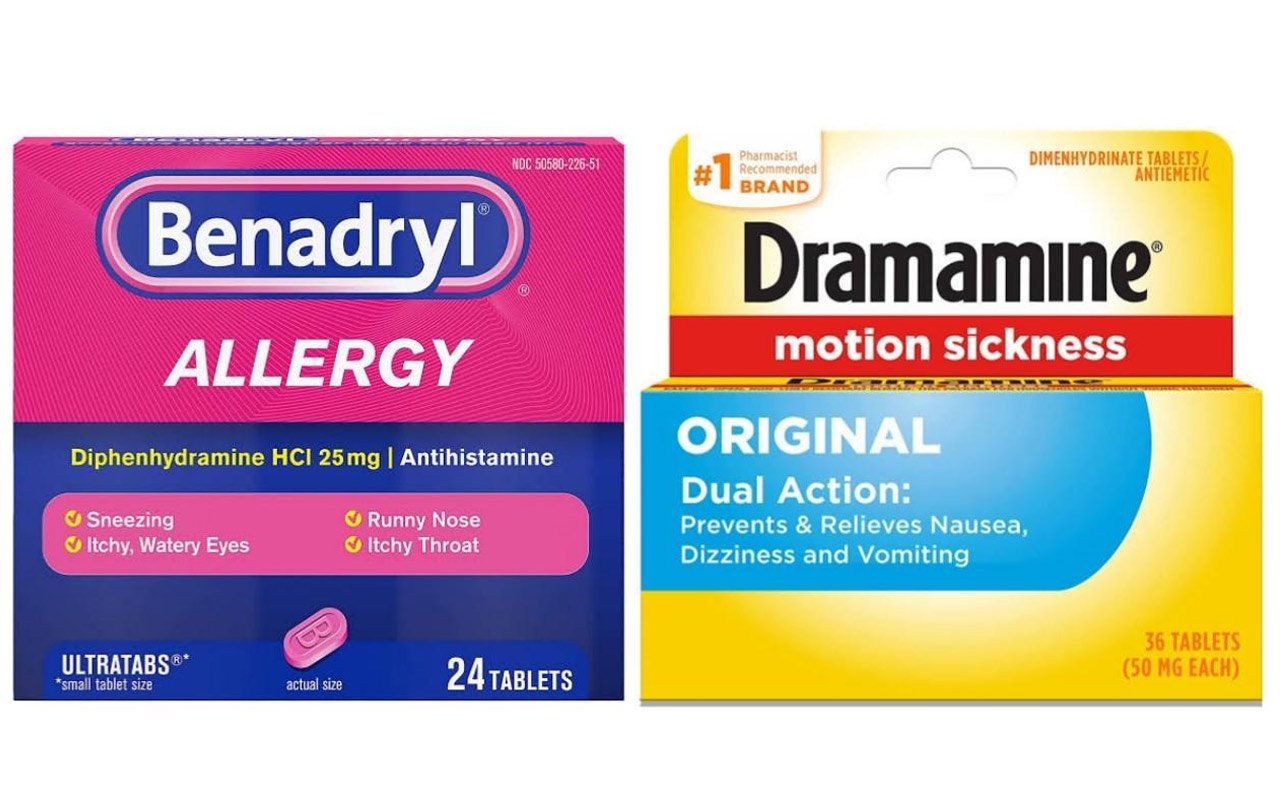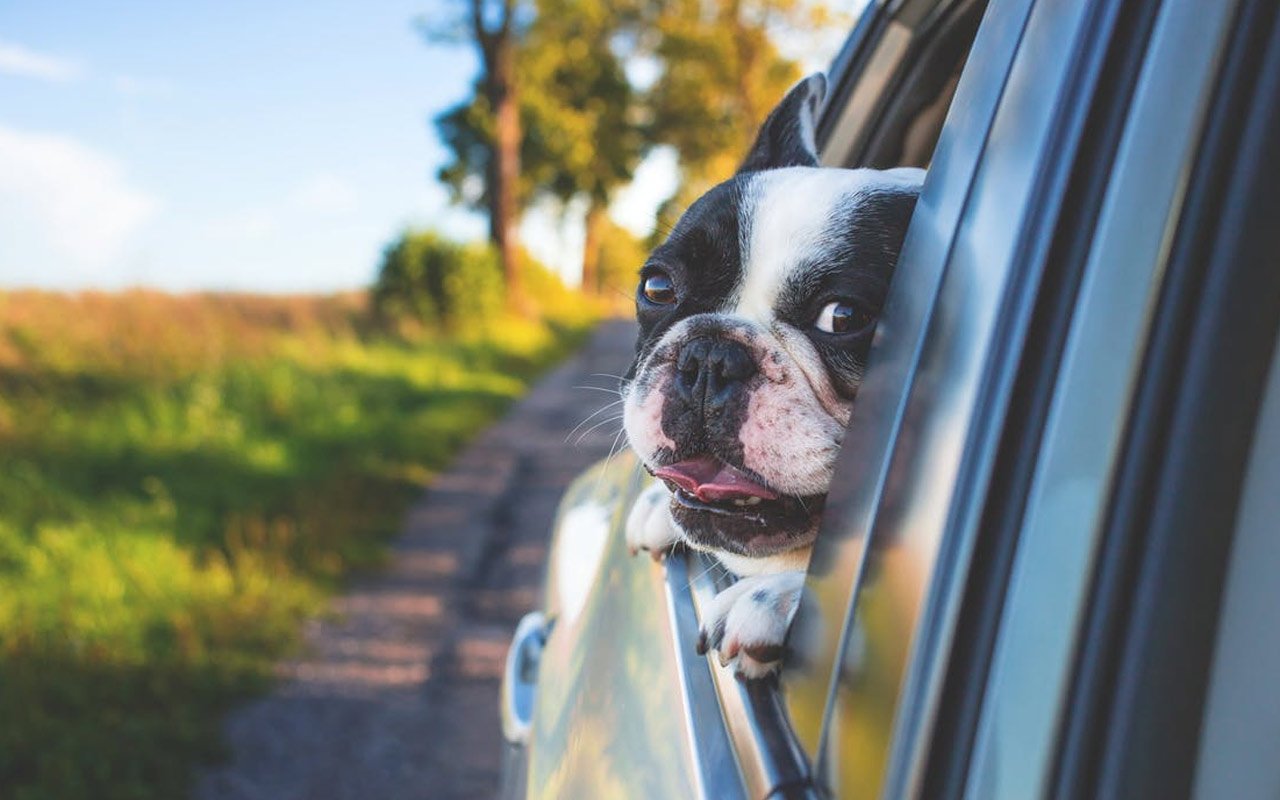Americans love their pets. According to the American Pet Products Association (APPA), in 2021, Americans spent more than $109.6 billion on their pets. It is no wonder that many people travel by their pets, which means dogs and cats often travel by car. Unfortunately, a lot of those dogs and cats get motion sickness. As a result, the pet owner may be forced to pull over and try to calm their pet or drive home with a sick animal.
Motion sickness (or the tendency to feel nauseous and get dizzy, then vomit when moving), is not a serious condition. It is common to all humans and even more common in dogs than in humans. Dogs are very sensitive to motion, which makes them prone to this condition.
Like humans, dogs can get carsick, too. But unlike humans, they can’t pull over to the side of the road when they start feeling queasy. And while car sickness in dogs isn’t as common as some veterinary professionals claim it is, your dog will feel better if you take the time to treat its motion sickness.
Dog car sickness is something that is common for many dogs and can turn into a real problem on longer trips. The causes of dog car sickness are not entirely understood, but we do know that smaller dogs are much more likely to have a problem than larger breeds. Dogs can suffer from motion sickness too, and this can occur at any age.
When it comes to car sickness in dogs, the unfortunate reality is that your dog’s chances of suffering from motion sickness are high, regardless of the breed. In fact, a study on dog motion sickness conducted by The American Society for the Prevention of Cruelty to Animals found that roughly 90% of dogs suffer from car sickness.
One of the most overlooked consequences of a dog car ride is motion sickness. Whether on a road trip, a run to town, or just a ride from the veterinarian, motion sickness can become a major issue for pet parents and their dogs.
While human travel sickness has been studied, the causes and treatments for canine travel sickness have been under-examined until recently. If you own a dog or you are planning to get one, then you should know about the state of car sickness.
You would definitely want to treat it to be able to enjoy the trip with your dog. But most importantly, you should be aware of the symptoms and the treatment options.

Table of Contents
What Causes Dog Car Sickness and Motion Sickness?
Dogs can experience motion sickness from conflicts between their sensory signals and the brain’s emetic (vomiting).
This means that the vestibular system of the inner ear, which is involved in balance, can conflict with the signals from your eyes. It could lead to nausea or vomiting similar to motion sickness.
Dogs can get motion sickness. Younger dogs are more likely to experience motion sickness or car sickness than older dogs. This could be because the inner ear parts that are involved in balance aren’t fully developed.
Adult dogs can become anxious and even nauseated when they travel. This is due to the lack of conditioning and the unusual stimuli that come with being in a car. Dogs who travel less than once or twice per year, usually to visit the veterinarian, aren’t used to car rides. They often associate car rides with stressful experiences.
This can cause anxiety and stress to increase, which may lead to vomiting and diarrhea. Dogs who have experienced traumatic or frightening first rides might also associate their future travel with this stressful experience.
Dogs may be predisposed to nausea by medical conditions like inner or middle ear infections, vestibular disease (a condition that affects the vestibular apparatus in the inner ear), or middle or inner ear infections. Some dogs may also be on medications that can cause vomiting and diarrhea.
This process involves many receptors, including:
- Chemoreceptor trigger zone (CRTZ)
- Histamine
- Neurokinin 1 substance P (NK1) receptors
Dogs can also get motion sickness from anxiety, fear, or previous trauma in a vehicle. Dog motion sickness can happen while traveling in any vehicle.
Because puppies are still developing their inner ear parts, they are more vulnerable than adult dogs. The good news is that motion sickness in puppies usually improves and resolves as they get older. By the age of one year, puppies will usually “outgrow” motion sickness.
Your dog will be able to travel with you more often if you help him overcome anxiety and stress.
Car sickness/motion syndrome is caused by certain movements that affect the balance center in the brain. This can be combined with anxiety/stress while traveling. Car sickness can affect older dogs as well as puppies.
Dog car sickness symptoms
People who feel nauseated often become pale or turn green when they feel their stomach upset approaching. Dogs can become sick from car sickness. This can lead to nausea, vomiting, and high-stress levels. These are signs that your dog might be suffering from motion sickness.
- Diarrhea
- Excessive drooling
- Lip licking or smacking
- Inactivity or lethargy
- Vomiting
- Whining and pacing
Stopping the car and taking your dog for a walk if you feel that your dog might vomit may temporarily help.
Medicine for Motion Sickness in Dogs
There are several pharmaceutical options available to prevent motion sickness in dogs. Two over-the-counter medications for dogs with motion sickness are
Benadryl (diphenhydramine) and Dramamine (dimenhydrinate).
Anti-sickness medication is sometimes a good short-term solution, but the best long-term solution is to help your dog stay healthy and get used to car travel so they don’t get motion sickness. Here are some medications for motion sickness dogs, the best short-term solutions for motion sickness in dogs.
Anti-nausea medication
Cerenia® (a veterinary-specific prescription medication) and dimenhydrinate (brand names: Dramamine® or Gravol®), and meclizine (brand names: Antivert® and Bonine®) are effective drugs for motion sickness in dogs.
These anti-nausea medications can prevent vomiting from a stressed pet. One dose of Cerenia lasts for 24 hours. These drugs are not effective for anxiety, but only for motion sickness.
Talk to your veterinarian to determine if these medications would be appropriate for your dog. Also, to ensure that the right dosages are being administered.
Cerenia
Cerenia (maropitant), is the FDA-approved prescription medicine for dogs suffering from vomiting due to motion sickness. It blocks the NK1 receptors at the brainstem vomiting center, which is responsible for nausea and vomiting due to motion sickness.
Cerenia is administered once daily to dogs who are at least eight weeks old. Cerenia is very effective. Only 7% of dogs vomit after being given in a study.
Meclizine
Meclizine, an antihistamine that has sedative and anti-vomiting properties, is available over-the-counter and on prescription. Drowsiness is the most common side effect. It should be taken once per day.
Dramamine and Benadryl

Benadryl (diphenhydramine), and Dramamine (dimenhydrinate) are two Over-The-Counter options for dogs suffering from motion sickness.
These antihistamines can be taken every 8 hours. They may also have sedative properties. Both Benadryl and Dramamine are antihistamines that can be given every 8 hours and may have sedative effects. Dramamine may be better tolerated given a small amount of food.
A small amount of food may make Dramamine easier to tolerate. Benadryl may cause gastrointestinal problems such as diarrhea and vomiting. One of the side effects of Benadryl is drowsiness. It has been used to help calm anxious dogs in situations like a thunderstorm. The Merck Veterinary Manual states that Benadryl, which is a similar medicine, may also relieve mild-to-moderate anxiety in pets who are traveling or experiencing motion sickness.
Benadryl is not recommended for use in combination with other products. The active ingredient should contain Benadryl (diphenhydramine).
- Using Benadryl together with Dramamine might increase side effects such as drowsiness, blurred vision, dry mouth, heat intolerance, flushing, decreased sweating, difficulty urinating, stomach cramps, constipation, heart rate irregularities, confusion, and memory problems in dogs.
- Dramamine and Benadryl are two different drugs. Dramamine is a brand name of dimenhydrinate, an antihistamine that reduces the effects of the natural chemical histamine in the body. Dramamine is used to treat or prevent nausea, vomiting, and dizziness caused by motion sickness.
Benadryl
Diphenhydramine (brand names: Benadryl, Vetadryl, Banophen, Genahist, Diphenhist, Unisom, Sominex) is an antihistamine that can be used on cats, dogs, and ferrets to treat allergies, motion sickness, and vomiting.
Benadryl can cause drowsiness in dogs, which helps calm anxious ones. According to the Merck Veterinary Manual, diphenhydramine can relieve mild-to-moderate anxiety symptoms in pets who travel. It can also relieve motion sickness.
Two to three times daily is the recommended dosing. Your veterinarian may recommend a different dose depending on your dog’s medical history or other medications. 50mg of Benadryl should be given to a 50-pound dog. It can come in two 25 mg tablets or four 12.5 mg chewable tablet forms, or 20ml of the Benadryl liquid (12.5 mg/5ml)
Dogs can be given Benadryl and Diphenhydramine quickly. It will usually take 1 to 2 hours to start working, but it can sometimes take less than an hour. The effects of Benadryl last 8 to 12 hours in dogs.
Benadryl can be used safely and effectively for dogs if it is administered according to the directions of a veterinarian. To ensure that your dog doesn’t have any adverse reactions, it is important to closely monitor them after administering any new medication.
Upper respiratory allergies can be caused by histamines in humans, but itchy skin can be caused by cytokines in dogs. Antihistamines are not effective in controlling cytokines, which cause inflammation and itching.
Your dog can be given Benadryl (diphenhydramine ) 2 to 3 times per day at 1 mg per pound . A 12-pound dog could receive 12mg. This is equivalent to half an adult dose or one children’s Benadryl. 50mg would be sufficient for a 50-pound dog, as well as two adult Benadryl. Benadryl may cause drowsiness.
Anti-Anxiety Medication
These medications should only be used in pets that are extremely stressed. Even the most anxious pet traveler can be relaxed by taking Xanax (Xanax(r),) trazodone(Desyrel(r), or any other prescribed medication, 12 hours before departure.
A majority of veterinarians recommend that you give your pet a second dose approximately two hours before you travel. To be effective, prescription medication should be taken at least a few days before you travel. Follow your doctor’s instructions.
Anti-anxiety medication and behavioral modification may be necessary if your dog experiences anxiety in the car.
Your veterinarian will be able to provide advice on safety and the best medication for your dog’s motion sickness.
Natural Remedies for Dog Motion Sickness

Some dogs can be susceptible to motion sickness. It’s not hard to believe that some dogs are susceptible to motion sickness after witnessing how excited canines get at the mere mention or idea of a ride in an automobile.
Although motion-sickness medications are available to help dogs who have been bitten by cars, holistic veterinarians recommend that dog owners look into natural options.
Here are some natural treatments suggestions for Your Car-Sick Dog:
- A few drops of lavender oil or chamomile oil can be applied to a cotton ball. Place it in the vehicle 30 minutes before you take off. The vehicle will be filled with a relaxing aroma. Be sure to get rid of the cotton ball, so that your dog doesn’t eat it!
- Spray the car with a little Dog Appeasing Pheromone (DAP).
- To settle your dog’s stomach, homeopathic remedies like nux vomica may be used.
- To help your pet develop a tolerance for long trips, take your dog on short trips.
- Limiting your dog’s car ride to visits to the vet’s will not help with anxiety.
Relaxing can help calm anxious canine passengers. A few natural remedies can be used to help dogs who are susceptible to car sickness. Dogs that suffer from motion sickness can find natural remedies.
Ginger
Ginger may reduce motion sickness for some dogs. Some believe that a ginger snap or two can help reduce motion sickness in dogs. Ginger can be safely eaten by dogs in small amounts. It has many health benefits.
The fresh ginger root is rich in antioxidants and has anti-inflammatory properties. This can help promote healthy blood circulation, reduce bloating, and improve heart health.
Ginger for dogs has been known to soothe upset stomachs. It’s safe for dogs. Ginger can help with bloating by stimulating the digestive process and aiding digestion. Ginger is also known for its anti-inflammatory properties, which can help prevent cancerous growths and ease arthritic pains.
Ginger can be used to calm queasy dogs just like it works for humans. Give your dog a teaspoon of ginger around 20-30 minutes before you take off. A small teaspoon is best for small dogs, while a larger spoon works well for large dogs (staffies and above). This is a common method that people find to be very effective.
Fresh ginger, or a powdered version of it, can be used to treat nausea and vomiting. Give your dog a few drops of ginger root extract 30 minutes before you take them on a car ride. If they are nervous about riding in the car, you can give them a ginger capsule.
Fresh ginger can be added to dog food. Many dogs will eat it finely chopped, grated or mixed in. For a treat, you can bake ginger, make a smoothie for dogs, or freeze it as small cubes. You should not give your dog more raw ginger than 1 teaspoon. Ginger can cause gassy, nausea, and heartburn in dogs who eat too much.
Anecdotal evidence suggests that ginger can be used to treat vomiting and nausea in dogs. Before giving it to your dog, consult your veterinarian. It should not be given if you have bleeding problems or if you are using anticoagulants (NSAIDs) or anticoagulants.
Adaptil
The calming pheromone for dogs, Adaptil, is available in either a spray or a collar. The collar can be worn daily to provide calming effects. However, the spray should be applied 15-20 minutes before travel or other stressful events.
Before you load your dog, spray the interior of your vehicle or travel kennel.
Calming Supplements
You can give your dog several supplements to calm them orally.
- Solliquin
- Composure
- Rescue Remedy
For maximum benefits, some products may need to be administered daily for several days or weeks. These products have few side effects, making them safe for most dogs.
Calming treats for dogs is generally safe. Many are made with natural ingredients like melatonin and chamomile, valerian root, and L-tryptophan to promote stress relief and calm.
L-tryptophan and L-theanine supplements are often recommended by veterinarians for mild to moderate anxiety. It can be used to treat anxiety in senior dogs who have developed new, age-related anxiety.
These types of products can cause nausea, vomiting, difficulty walking, depression, lethargy, and even urinary incontinence. These signs may last for up to 72 hours if they are not treated promptly. To prevent injury, your pet should not be allowed to incoordinate.
While some over-the-counter medications can help with anxiety in dogs, they are less effective for treating more severe cases. Supplements such as melatonin have been used to reduce anxiety. They are readily available at most grocery stores and pharmacies.
The best Calming Supplements for Dogs
- NaturVet Quiet moments Calming Aid Dog Soft Chews
- VetriScience Composure Behavior Health Bite-Sized dog chews
- Zesty Paws Anxiety and Stress Bites
- Rescue Remedy Stress Relief Pet Supplement
- Pet Naturals of Vermont Calms Cat & Dog Chews.
Lavender
You can also spray lavender essential oil with safety. A cotton ball can be soaked with lavender essential oil, and placed in your car for a few minutes.
You should make sure that your dog does not ingest the cotton ball during or after the trip.
CBD Supplements
CBD is a safe and efficient alternative. CBD oil or dog biscuits can be used to calm your pet before you take them on a ride. It can help with nausea in dogs.
CBD has anti-nausea properties that can prove very useful if your dog is car sick. It naturally relaxes your dog and lowers his travel anxiety, so that he can enjoy the trip with you. CBD products are available in many forms, but CBD oil remains the most effective.
0.22mg of CBD should be given per pound. If your dog weighs 10 pounds and is a Bichon Frise, for example, you would give him 2mg CBD oil.
When you are on the move and don’t have time to feed your pet oil, tiny bites can be a great option. To allow the oil to begin to work, it is essential to give your pet their dose at least an hour before you go. When your dog gets sick from the car, be calm and patient.
Our 1000mg CBD oil is easy to use and delicious. It promotes joint health, and anxiety reduction, and lowers inflammation. Can be used directly on the pet’s food, or as a treatment. For medium-sized dogs between 20-50 lbs and up, a supply of 30-60 days is recommended.
Many people wonder if CBD oil is able to help dogs with anxiety. It can. CBD can help your dog feel calmer and more relaxed, regardless of whether they are anxious about travel or loud noises. Dog owners are concerned that their pets may become high from CBD.
The majority of cases do not require any treatment other than symptomatic care for gastrointestinal problems if they occur. Mild sedation, hyperesthesia, urinary incontinence, and hyperesthesia could occur if the pet is given a high dose of THC.
Veterinarians should not recommend CBD products but they can help pet owners to weed through the many companies that offer products
The half-life of CBD oil in dogs is 34.2 hours, according to research. This means that should be taken twice daily. Cbd can be given to your dog daily. Cbd oil can be given to your dog every day, depending on its reason. Regular administration will help to regulate their endocannabinoid system and allow all of the homeostatic properties of CBD to work with it.
CBD (cannabidiol) is another product that you might want to try for your dog’s motion sickness. CBD is now more readily available in many forms including oil, chews, and treats.
There are many regulations regarding CBD. The quality of CBD products may not be guaranteed. To discuss the best options for CBD treatment of motion sickness in dogs, please contact your veterinarian.
Frequently Asked Questions
How to help dog car sickness?
These are some additional tips to make dog travel more enjoyable and less stressful.
- Avoid eating 12 hours prior to travel: A full stomach can reduce nausea and prevent the need for frequent toilet breaks, which are often uncomfortable during long car rides, airplane travel, or train travel.
- A carrier or safety harness is a good choice for anxious dogs. They can cause injuries and accidents. Many dogs consider a carrier to be a "safe space" for their dog.
- Keep your car cool and quiet - Play soft classical music to keep the car cool.
- Give your dog the sweet scent of home by adding a t-shirt, blanket, or scarf with your scent to their carrier. Nothing is more comforting than mom and dad's shirt.
- Give your dog special toys for trips: Helping your dog associate travel with fun can be a great way to help him learn about the world.
- Dog pheromone (Adaptil): To calm your dog's fears, add these scents to his bedding.
- Calming herbs These natural remedies include valerian, passionflower, and ginger. They have been used for years to alleviate anxiety and motion sickness.
Can you give a dog Dramamine for car sickness?
Medium-sized dogs and large dogs should receive 25 to 50 mg of Dramamine within an hour before they travel in a car. Cats and small dogs should consume about 12.5 mg. Before giving any medication to your pet, make sure you consult your veterinarian. All-natural pet tranquilizers are recommended.
How much Dramamine can I give my dog for motion sickness?
The average veterinarian recommends a dose of 2 to 4 mg per dog's bodyweight. This should not be done more than once every eight hours. Dogs should be given the medication at least 30 minutes before they travel.
Can I give my dog human Dramamine?
Dogs can take common human travel sickness tablets such as Dramamine and Gravol. The active ingredient is dimenhydrinate. Dogs can take 4-8 mg per kilogram of their dog weight daily, and up to three times daily. Benadryl, active ingredient diphenhydramine hydrochloride.
How much Dramamine can you give a 20lb dog?
Talk to your vet before giving Dramamine to dogs. However, most vets will only prescribe Dramamine at a dose of 2 mg per pound and should be administered no more than 3 times daily. You can give 40 mg to a 20-pound dog 40 mg every eight hours.
What can I give my dog for motion sickness in the car?
Cerenia(r), a veterinary-specific prescription medicine, and dimenhydrinate. (brand names Dramamine(r), Gravol(r), and meclizine. Brand names: Antivert (r), and Bonine(r). These medications can prevent vomiting from a stressed pet.
Which Dramamine is best for dogs?
For any breed of dog, 25-50 mg should be administered up to three times daily by some vets. The medicine's effects usually last for 3 to 6 hours. You can take 25 mg of meclizine once daily to manage nausea and vomiting if you are using a formulation containing it as the active ingredient.
How long does Dramamine last in a dog?
The short-acting medication should be stopped within 24 hours. However, pets suffering from liver disease or kidney disease may experience longer effects.
Is Benadryl or Dramamine better for dogs?
Both are antihistamines and can be taken every 8 hours. They may also have sedative properties. A small amount of food may make Dramamine easier to tolerate. Benadryl may cause gastrointestinal problems such as diarrhea and vomiting.
Are Benadryl and Dramamine the same thing?
The Food and Drug Administration approved older over-the-counter antihistamines, such as diphenhydramine and dimenhydrinate (Dramamine), for children aged 2 and above.
Does Benadryl help dogs with car sickness?
Benadryl, an over-the-counter antihistamine that is commonly prescribed for humans, can be administered to dogs to address a variety of health issues. Benadryl is well-known for its ability to relieve symptoms such as allergies and allergic reactions. However, it can also help calm anxiousness and motion sickness in dogs.
Does Dramamine make dogs drowsy?
Dogs who have received Dramamine treatment may experience dry mouth. Lethargy. Sedation.
How long does car sickness last in dogs?
For some dogs, motion sickness is the result of an underdeveloped vestibular system - which is why many puppies seem to get milder motion sickness as they get older. than. Young dogs with vestibular problems often experience more severe motion sickness and likely won't get motion sickness again by the time they are 5-6 months old.
How long does it take Dramamine to take effect?
For the best results, take Dramamine 30-60 minutes before you travel or engage in any activity that could cause motion sickness.
Can I give my dog Dramamine and Benadryl?
Both Dramamine (dimenhydrinate), and Benadryl, (diphenhydramine), are H1 receptor antagonists. This means that they both do the exact same thing as antihistamine drugs. You should always consult your vet before giving your dog any medication.
Does Dramamine come in liquid?
Dramamine Junior Liquid can be used to prevent and relieve nausea and vomiting caused by motion sickness, vertigo, and electroshock therapy.
Can I give my dog 50 mg of Benadryl?
A 50-pound dog should be given 50 mg of Benadryl. It can come in two 25 mg tablets or four 12.5 mg chewable tablet forms, or 20 ml liquid Benadryl (12.5 mg/5ml).
Can dogs take Dramamine?
Dimenhydrinate (Dramamine), which is the same drug that people use to prevent car sickness, can be used for pets. Medium-sized dogs should take 25 to 50 mg of Dramamine before they travel in a car. Cats and small dogs should consume about 12.5 mg.
Does Dramamine prevent vomiting?
Dramamine details) is an antiemetic, which means it prevents vomiting. It was used to treat motion sickness-related nausea, vomiting, and dizziness. It works by blocking the brain's nausea-inducing receptors in your stomach.
Will Benadryl stop my dog from throwing up?
Diphenhydramine (brand names: Benadryl (r), Vetadryl (r), Banophen (r), Genahist (r), Diphenhist (r), Unisom (r), Sominex(r)) is an antihistamine that can be used to treat allergies, motion sickness, and other symptoms in dogs, cats, horses, and birds.
How do I calm my dog in a long car ride?
Keep this in mind when you put a blanket or toy in your car. You can use a crate from your house to fit into the car. You can give him a treat and praise his good behavior. Don't scold "bad" behavior like barking.
How do I get my dog to stop crying in the car?
To teach a substitute behavior, such as "be quiet" or "sit and gaze at me", you will need to use treats in the car. A crate, blanket, or favorite toy can be helpful in calming anxious dogs. Don't punish or yell at your dog. This will only cause anxiety and increase noise.
Why does my dog go crazy in car?
Many dogs love to ride in the car. This means that the dog is excited to go on an adventure, even if it's just a trip in the car. Dog owners often mistakenly believe that dogs are happy when they see them excited. Dogs can be happy, calm, or anxious.
Why does my dog pant and shake when riding in the car?
Some dogs are more sensitive than others and can be affected by car rides. Hypersensitive dogs are more sensitive to physical stimuli like sight and smell. This can result in shaking that is due to their increased awareness of the environment.
Why do dogs bark at cars driving by?
Dogs bark for many reasons, and it’s important to determine the reason before trying to fix the behavior. There are three main reasons dogs bark in the car: anxiety, barrier aggression, and excitement.
Can I give my dog human travel sickness tablets?
Dogs can take common human travel sickness tablets such as Dramamine and Gravol. The active ingredient is dimenhydrinate. Dogs can take 4-8 mg per kilogram of their dog's weight daily, and up to three times daily. Benadryl, active ingredient diphenhydramine hydrochloride.
Do dogs ever get over car sickness?
The use of medication may be beneficial for dogs that aren't able to overcome their motion sickness or don't respond well to conditioning. There are many prescription and over-the-counter medications that can reduce your dog's symptoms of motion sickness. These include anti-nausea medications.
Is my dog car sick or anxious?
Sometimes, motion sickness can persist into adulthood. But that's rare. Dogs often feel sick while driving, especially if they are experiencing emotional distress. Fear of car rides, especially in young dogs, is a common emotion that dogs experience after separation anxiety.
Can you buy car sickness tablets for dogs?
Your vet may also recommend maropitant tablets. Although these tablets can be quite costly, they are extremely effective in reducing nausea and vomiting associated with motion sickness. Although they are effective in most cases, they are not recommended for long trips or holidays.

